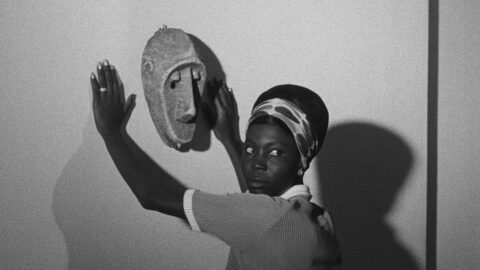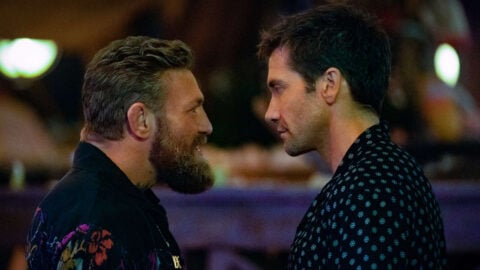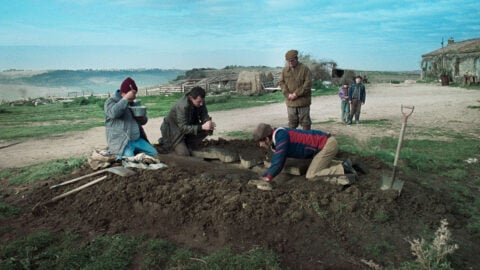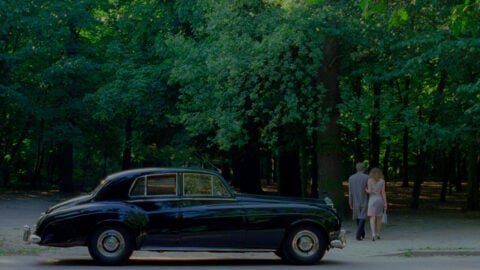This Is DCP: Is That It?
 |
A frame from the negative of The Bridge on the River Kwai | |
 |
The same frame, in DCP, after digitally re-registering the individual color records (red, green, blue) to eliminate the blurry, ghosting effect |
Film Forum’s “This Is DCP” series officially kicked off last Friday with a digital reincarnation of Stanley Kubrick’s Dr. Strangelove (following a matinee of the underrated The Guns of Navarone). On hand to present the restoration was Grover Crisp, Sony’s Executive Vice President of Asset Management, Film Restoration, and Digital Mastering. Microphone at the ready, he conducted an informal presentation and running Q&A session while on the screen two versions (and visions, really) of Dr. Strangelove were shown in alternating clips.
It was immediately clear which was the 35mm print and which was the 4k digital version (here projected in 2k, the maximum resolution of the house projector). The DCP looked notably bright, its sound and image remarkably clear and steady. Details unearthed by the restoration emerged with new clarity: individual beads of sweat on General Jack Ripper’s face, the texture of his cigar, the pattern on Miss Scott’s bikini, the hard plastic grooves of the instrument panels and the precise black lines on the maps aboard the rogue plane.
DCP or “Digital Cinema Package” is a proprietary format of compressed and encrypted data files which are transmitted to theater projectors by broadband or hard drive. The format in which Dr. Strangelove was scanned, intended to replace 35mm film, provides about ten times the resolution of DVD and four times that of Blu-ray. Dr. Strangelove was a particularly compelling candidate for digitization (originally begun in 2004) because the original negative was lost to overprinting and carelessness in the Sixties. Forced to make negatives from two fine-grain master positives, the notoriously exacting Kubrick could never get the film to look the way he wanted it to, particularly in terms of contrast and density. The DCP was made from the one surviving master positive struck from the negative which Kubrick used to make all official prints; Crisp and his team worked with Leon Vitali, Kubrick’s primary assistant for over 25 years.
As the presentation continued, a kind of DCP ars poetica began to emerge. Stressing the “very keen awareness of preservation” that is required for proper DCP restoration, Crisp made clear that “the grain is the source of the image, of the sharpness and detail, so we don’t remove it.” Indeed, the DCP Strangelove was grainier than the print (itself several generations removed from the original negative), which he explained was the result of multiple emulsions. As with the DCP’s brightness, however, the idea is that viewers will adapt to watching its more granular picture.
Asked whether he thought something might be lost in the move away from film, Crisp revealed that he didn’t disagree with the notion that film is the proper medium for cinema: “I used to be one of those people [who] looked through the calendar and when [they] saw there was a brand-new 35mm print, said, ‘Oh, I’m there!’ And I would love for people to say, ‘Brand-new 4k restoration — I’m there!’ because inevitably someday there will not be prints . . . It took a long time for me to come around . . . Photochemical film will be going away . . . so now is the time to be doing these things the right way.”
Crisp was cognizant that his declared standard for digitization was not shared across the industry: “Some people actually like the smooth look, and those are people who never knew film or cared about film, even though they might be movie buffs. And there are some journalists like that [whom] I hear from all the time.” But he went so far as to suggest that the 4k version might realize the dream of directors (and many cinephiles): the digitized version projected “allows you to look at the image that they were looking at through the viewfinder, that they thought they were capturing. The traditional photochemical process tends to bury some of that detail.” Proffering a kind of communion with the director, the ability to see through his or her eyes, makes for a powerful sell.
As for color films, Crisp acknowledged that their conversion for DCP is far more complex, especially when different color processes are involved. That much was clear when Crisp gave a sneak preview of Sony’s restoration of Lawrence of Arabia, which is being prepared for the movie’s 50th anniversary. Also screened using a 2k projector, this Lawrence was originally scanned at 8k, because the film had been shot on the more “data”-dense 65mm. The blue desert sky was blindingly bright. Was this a more accurate rendering of what David Lean saw on that scorching day, or evidence of digital’s gradual estrangement of the audience from the aesthetics of photochemical film?
Crisp’s presentation suggests that the whole process is not doing away with film, but digitally coaxing it into becoming more like itself. The problem of evolving technologies is one that the cinema has always faced, from the phenakistoscope to 4k: it is pulled towards standardization which threatens its past, and punished by time which threatens its future. The urge to preserve film coincides with a set of desires at the heart of cinema itself to make the past last, to achieve some mastery over the affective dimensions of memory.
Yet even with the invaluable efforts of Crisp and others, it seems unlikely that preservation in the age of DCP can be done on any meaningful scale. With all the time and money required to make a digital transfer, only a tiny fraction of extant prints will ever find their way to digital ecstasy, leaving the rest to fade away.
“This Is DCP” runs through Thursday, March 8, at Film Forum.







